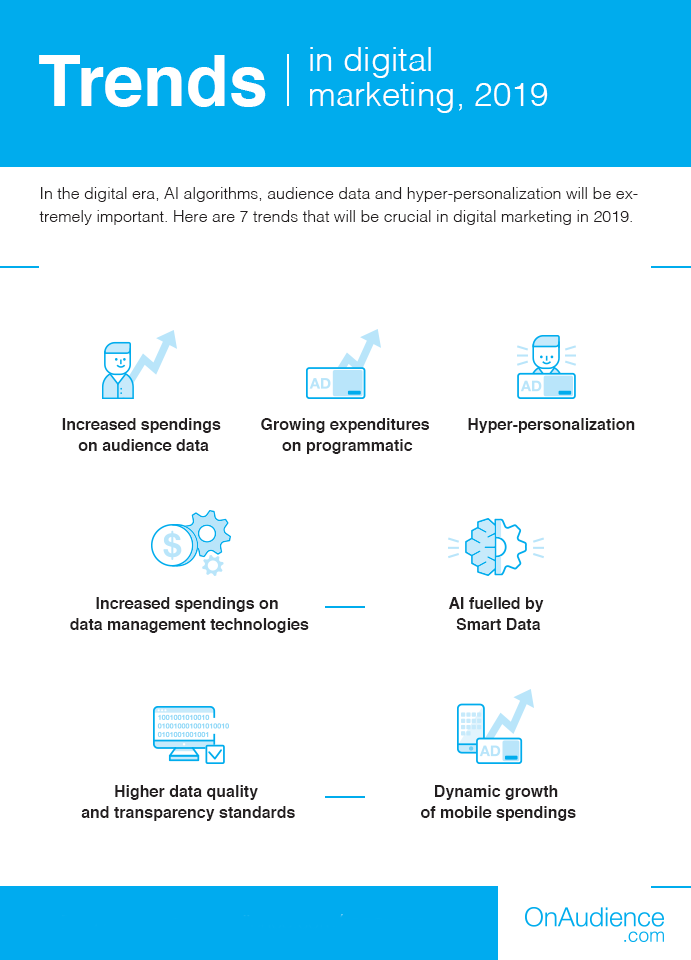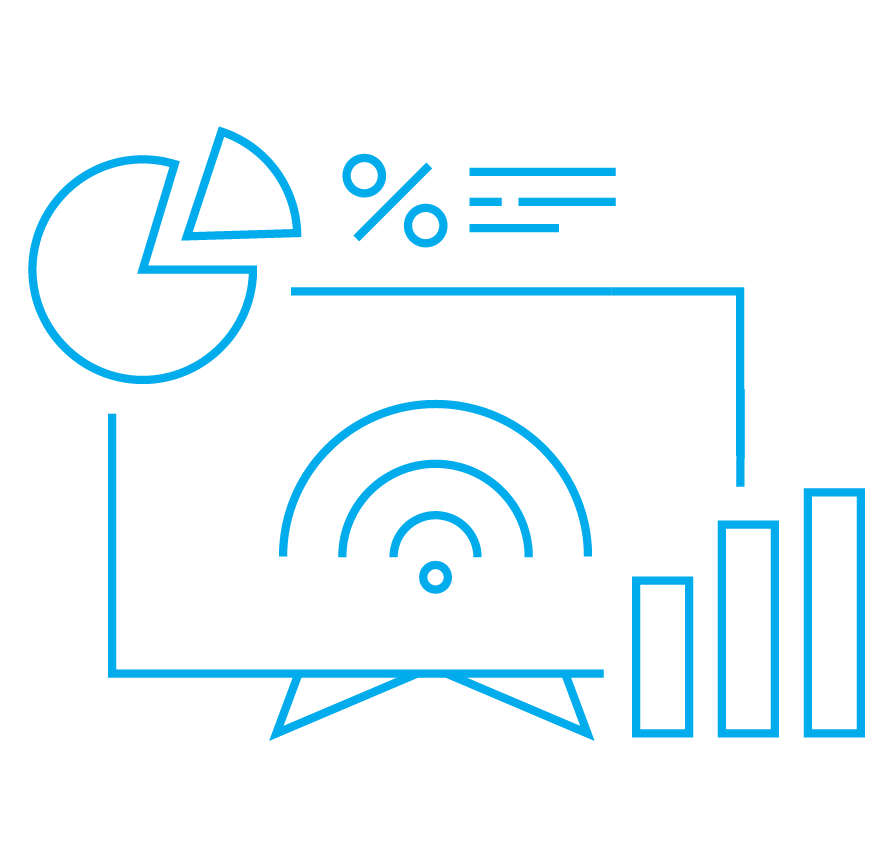- 7 trends in digital marketing in 2019
- 1. Higher expenditures for audience data
- 2. Programmatic spendings will grow dynamically
- 3. Hyper-personalization will become a crucial element of online campaigns
- 4. Increased investments in data management technologies
- 5. The growth of AI powered by Smart Data
- 6. Data transparency and quality will become extremely important
- 7. Spendings on mobile ads will still grow fast
Technological development is growing fast. Tools that use Artificial Intelligence, such as voice assistants or mobile apps – are with us during everyday activities. The area where companies often implement innovative technological solutions is a digital environment, especially – digital marketing.
Online marketing, which grows dynamically and since last year global spendings for this area overtook expenditures for TV ads, is a field where companies implement innovative technological solutions, based on Artificial Intelligence, machine learning or Big Data analysis.
What trends can be observed in digital marketing and big data market next year? In the age of digital era, AI algorithms, audience data and hyper-personalization will be extremely important. Here are 7 trends that will be crucial in 2019. See the infographic and details below.
7 trends in digital marketing in 2019

1. Higher expenditures for audience data
Audience data is a foundation of digital advertising. It helps in reaching the right audience and increases the effectiveness of conducted campaigns. Data management and customer experience will be one of the key drivers of marketing success in 2019, according to WARC. The company sought the views of 800 brands and agencies from all over the world. What’s interesting, implementing solutions based on data mentioned almost every CMO.
Marketers’ declarations are reflected in numbers. According to IAB/Winterberry Group report, in the USA, which is the world’s largest data and advertising market, spendings for digital data and data management technologies will exceed $19 B. It is a growth of 17.5% YoY.
Spendings on 3rd party data will grow of +17.7% YoY and will hit $11.9 B this year. Check how to use the power of 3rd party data in digital marketing.
2. Programmatic spendings will grow dynamically
Marketers see great results of programmatic campaigns. That is why they invest larger budgets in this advertising model. Reaching the right group at the right time is appealing for marketers from all over the world. According to “Global Data Market Size 2017-2019” by OnAudience.com, global programmatic spendings will hit $89.5 M next year, which is a growth of over 19%.
On the US market, which is the world’s largest programmatic market, advertisers will spend over $46 B. It is more than 82% of all digital display expenditures, according to eMarketer.
Spendings on programmatic grow also on the UK market. According to OnAudience.com report, marketers will spend $5.7 B this year and this amount will grow to $6.6 B in 2019 (+14.9% YoY).
3. Hyper-personalization will become a crucial element of online campaigns
Higher expenditures on audience data and programmatic campaigns lead to delivering highly personalized messages. By using AI algorithms and Big Data analysis, marketers can run hyper-personalized campaigns – tailored to the interests, intentions and demography of a target group.
Currently, just 9% of marketers have its own hyper-personalization strategy, based on AI algorithms, according to Marketing Dive. But 61% of marketers plan to improve customer experience by using hyper-personalized content. More than a half of marketers declared that using insights from data analysis in decision-making is important for them.
eMarketer analyzed trends in loyalty marketing and also highlighted content personalization. Marketers use personalization most often for: web experience engine – tailoring website content to individual (45%), promotion of content which is automatically tailored to individual profile (50%) and use of look-alike advertising engine, which allows marketers to target users with profile similar to the best converting clients (45%).
4. Increased investments in data management technologies
The growing market of data-based services implicates a need for technologies for gathering, storing and managing big data sets. Therefore, expenditures mainly on Data Management Platforms will grow by 25% this year. According to the IAB/Winterberry Group study, investments in technologies for data management will hit almost $5.0 B this year.
Authors of the report indicate that expenditures are growing mainly because of introducing new data privacy rules (GDPR in Europe and CCPA in the USA). Technology will help them comply with new privacy regulations. By using one, centralized platform marketers can automatically anonymize all processed audience data which help them comply with new privacy rules. Check how to process customer data and comply with GDPR by using DMP.
5. The growth of AI powered by Smart Data
AI is present in our everyday life. Media from all over the world writes about autonomous cars, global tech leaders invest in voice assistants, such as Siri (Apple) or Google Duplex. Machine Learning and AI algorithms are used in self-service stores, such as Amazon Go, where all buying process is controlled only by machines.
In Big Data Marketing, AI gains a great piece of knowledge, which is data about Internet user behavior. By analyzing billions of digital information machines generates Smart Data from big and chaotic data sets. This fuel help AI to discover the best way to reach new clients in the digital environment.
According to eMarketer study, 48% of US marketers believe that AI will help them in discovering audience insights from large data sets. What’s more, 53% of B2B marketers think AI will boost marketing success, according to Marketing Dive. Use of AI algorithms in online campaigns will help in preparing highly personalized messages delivered in the programmatic model.
6. Data transparency and quality will become extremely important
Introduction of new data privacy regulations in Europe (GDPR) implicates significant changes in the digital marketing industry. Data providers need to prove that the information they offer is of high-quality and is processed in compliance with the new regulations. To meet the new challenges, advertisers will control the quality and origin of their data even more precisely.
This year IAB Europe established IAB Transparency & Consent Framework – the initiative that helps companies to comply with GDPR. Developed standard help in improving the quality of provided data and makes it highly important to take care of users privacy.
Commitment to data transparency will lead to offering high-quality and verified segments. It will bring greater trust of advertisers to data providers and using a higher quality of data will improve the efficiency of conducted campaigns.
7. Spendings on mobile ads will still grow fast
Mobile revolution, low-costs of mobile devices connected to global network bring spectacular growth of spendings on mobile ads. According to eMarketer, expenditures on mobile ads will be still growing fast and in 2022 will constitute almost 48% of all US marketing spendings.
This year, mobile ad spending in the US will be an astounding 75% of all digital ad spend, according to Forbes. It is a growth of nearly 22,000% from a decade ago. Mobile spendings are growing because we use mobile devices more often in everyday situations, such as shopping, listening to podcasts or reading.
Mobile marketing makes it easy for advertisers to precisely reach target audience by using information not only about the behavior or interests of Internet users but also about localization or stores visited in shopping malls. So that, mobile has a great potential for sending hyper-personalized messages.



